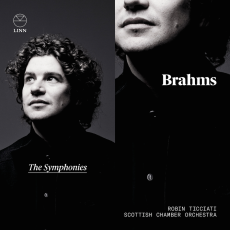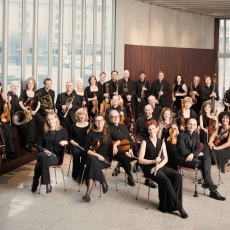Robin Ticciati & SCO - Brahms: The Symphonies - Europadisc
As a parting gift in his last season as the Scottish Chamber Orchestra’s principal conductor, Robin Ticciati has set down one of the cornerstones of the repertoire: the four symphonies of Johannes Brahms. These are works the orchestra knows well, not least from a series of concerts before these studio-condition recordings in Edinburgh’s Usher Hall, and it shows in performances that combines youthful vigour with matchless musicianship.
The SCO last recorded these symphonies as part of a benchmark Brahms cycle with their conductor laureate, Sir Charles Mackerras, a full twenty years ago, and the new set builds on his achievement by delivering performances close in scale and sound to those Brahms himself is known to have favoured. Like Mackerras, Ticciati employs a string section of just 34 players (10 first violins, 8 seconds, 6 violas, 6 cellos and 4 double basses), slightly larger than the 30 regularly used by the Meiningen Court Orchestra, with whom Brahms had a particularly special relationship in this music. Trombones are narrow bore, the horns are late 19th-century Viennese, and the hand-tuned timpani have calfskin heads and are played with hard sticks, cutting through the beautifully transparent textures to thrilling effect. Combined with the small string section, this means that there’s no need for recourse to doublings for the woodwind section – one of the set’s many glories – to be fully audible even in the scores’ busier passages.
Unlike Mackerras and other more recent conductors, Ticciati omits the exposition repeats in the First and Second symphonies (but not the Third), following to the letter the approach of the great Brahms conductor and director of the Meiningen orchestra Fritz Steinbach (1855-1916), whose conducting of these works Brahms greatly admired. It also enables Linn to present the works in chronological order, with Symphonies 1 and 2 on CD1, and 3 and 4 on disc 2, so that the listener can readily savour Brahms’s steady growth from the titanic struggle of the First Symphony, through the pastoral landscapes of the Second and the intensely personal Third to the assured reforging of the past in the Fourth.
Antiphonally divided violins are nothing new in Brahms symphony recordings these days, but the SCO players are really on their mettle in those passages – notably in the First and Fourth symphonies – where Brahms exploits this, and it is in these more forthright outer works that Ticciati is arguably at his strongest. (There are few more magical moments in music than the sound of a period Viennese F horn in the Alphorn melody that crowns the slow introduction to the finale of the First Symphony.) That’s not to say that the Second and Third are lesser performances: the SCO players clearly relish their colours and the opportunities for more individual expressivity, and there is much to admire here, not least in glorious, intermezzo-like middle movements of the Third.
Again like Mackerras before him, Ticciati has clearly learnt much from the performance practice of Steinbach, as transmitted by Steinbach’s pupil Walter Blume, although he focuses on different details, such as the imprecation to press onwards at the closing cadential passage that ends the exposition and recapitulation of the First Symphony’s finale. Other localised instances of ‘elastic’ tempi, many worked out in collaboration with the SCO players in the course of rehearsals and performances, serve as ample demonstration that Ticciati has embraced the principle of expressive tempo modification that Brahms is known to have advocated.
Where this set will perhaps divide opinion – and in clear distinction from the Mackerras cycle – is the use of minimal vibrato by the strings, combined with frequent use of portamento: the technique of sliding between certain notes on the string. Both techniques are idiomatic to historically informed Brahms performance, and Ticciati has clearly learned much about the former in particular from the pioneering work of Sir Roger Norrington. This gives a decidedly ‘period’ feel to these modern-instrument performances, as does the ‘shaping’ of the timpani pulse at the outset of the First (the hand of Norrington again). Passages like the opening of the Fourth Symphony, where the SCO violins most clearly apply portamento, will certainly prove ‘Marmite’ moments for many: you’ll either love them or hate them. Yet it’s definitely worth taking time to live with these performances, which consolidate the achievements of Mackerras and Norrington – two of recent musical history’s most significant Brahmsians – and combine them with the SCO’s superb musicianship and Ticciati’s unmistakable imagination and energy, to create a cycle that really is worth celebrating.


